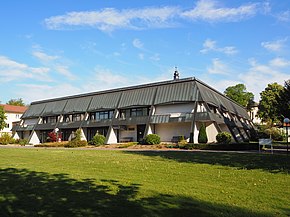Bonifatiushaus (Diocese of Fulda)
The Bonifatiushaus is the Catholic Academy and the seat of Catholic adult education in the Diocese of Fulda .
history

In 1938 the first diocesan educational institution was established in Fulda with the Christ the King's House. However, the beginning of the Second World War affected the educational work, since the house was used as a hospital . In order to react to the consequences of the National Socialist propaganda after the end of the war , a new training center was set up in 1948, which was placed under the patronage of St. Boniface . The Bonifatiushaus became a center for retreats, courses and conferences for religious and social training for adults and young people. It was open to church groups as accommodation, but did not yet offer its own program.
Since the spatial capacities were quickly exhausted, the diocese built a new building for the Bonifatiushaus a few years later on the economic area of the former Benedictine priory St. Andreas in Fulda-Neuenberg. Bishop Johannes Dietz gave it to its destination in 1954, the year of the Boniface Jubilee and the German Catholic Day in Fulda.
In the years that followed, the Bonifatiushaus changed from a training home to an open educational facility and from 1970 offered its own educational program as the “House of Continuing Education of the Diocese of Fulda”. In addition to diocesan funds and participant contributions, the expansion of educational work was also financed from grants for political and social educational work, etc. a. from the Federal Agency for Civic Education . In 1981 the Bonifatiushaus was admitted to the academy leadership group.
In November 1980, Bishop Eduard Schick inaugurated an extension. With regard to the structure of the old monastery, the new building is grouped around an atrium that resembles a cloister and at the same time takes up the classic design of academy buildings.
Today the Catholic Academy of the Diocese of Fulda sees itself as an important interface in the dialogue between church and society. In addition to lecture, conference and seminar rooms, the house also offers the opportunity to stay overnight. The current director is Gunter Geiger (as of 2020).
Mission statement and self-image
The model of the Catholic Academy follows the concept of a Christian image of man , which locates the person as a self-responsible individual in the context of social requirements and responsibility. This personal image of man implies his origin as part of creation and as the image of God .
According to the academy, the dignity that arises from this is reflected in many other aspects, as well as in the vision of equity that is guaranteed through education and training.
In contrast to economized educational processes, which primarily focus on employability , the Academy's offers, as evidenced by their mission statement, place people holistically in the center so that they can develop further. Based on this understanding, on the one hand, social processes are mapped in the program of the Bonifatiushaus in terms of educational theory and practice. On the other hand, from a Christian point of view, occupation also has an impact on the overall social discourse in that certain topics can be interpreted differently and in new ways in the light of faith.
As an academy for further education of the diocese of Fulda, the Bonifatiushaus u. a. Seminars and events on religious, theological, socio-political, medical-ethical and creative topics.
literature
- Elisabeth Eicher-Dröge: In dialogue with the Church and the world? Catholic academies in Germany. Identity over the course of five decades (1951-2001). Munster 2004.
- Oliver Schütz: Meeting of Church and World: The Founding of Catholic Academies in the Federal Republic of Germany 1945-1975. Paderborn 2004.
Web links
- Literature from and about Bonifatiushaus (Diocese of Fulda) in the bibliographic database WorldCat
- Bonifatiushaus Fulda
- Catholic adult education Hessen
- Working Group for Catholic Social Educational Organizations (AKSB)
- Catholic academies in Germany
Individual evidence
- ↑ a b Oliver Schütz: Meeting of Church and World: The Foundation of Catholic Academies in the Federal Republic of Germany 1945-1975. Paderborn 2004, p. 482.
- ↑ a b Oliver Schütz: Meeting of Church and World: The Foundation of Catholic Academies in the Federal Republic of Germany 1945-1975. Paderborn 2004, p. 483.
- ↑ Oliver Schütz: Meeting of Church and World: The Founding of Catholic Academies in the Federal Republic of Germany 1945-1975. Paderborn 2004, p. 484.
- ↑ Oliver Schütz: Meeting of Church and World: The Founding of Catholic Academies in the Federal Republic of Germany 1945-1975. Paderborn 2004, p. 486.
- ↑ Oliver Schütz: Meeting of Church and World: The Founding of Catholic Academies in the Federal Republic of Germany 1945-1975. Paderborn 2004, p. 487.
- ↑ a b Oliver Schütz: Meeting of Church and World: The Foundation of Catholic Academies in the Federal Republic of Germany 1945-1975. Paderborn 2004, p. 489.
- ↑ Elisabeth Eicher-Dröge: In Dialogue with Church and World? Catholic academies in Germany. Identity over the course of five decades (1951-2001). Münster 2004, pp. 14–15.
- ↑ Oliver Schütz: Meeting of Church and World: The Founding of Catholic Academies in the Federal Republic of Germany 1945-1975. Paderborn 2004, p. 490.
- ↑ Bonifatiushaus - educational center and academy in the diocese of Fulda - profile of the Catholic academy Bonifatiushaus. Retrieved January 22, 2018 .
- ^ Bonifatiushaus - educational center and academy in the diocese of Fulda - team. Retrieved January 22, 2018 .
- ^ Academies> Academies> Fulda. Retrieved July 10, 2020 .
- ^ Bonifatiushaus Fulda - educational areas. Retrieved July 10, 2020 .
Coordinates: 50 ° 33 ′ 5.2 ″ N , 9 ° 39 ′ 41.3 ″ E

